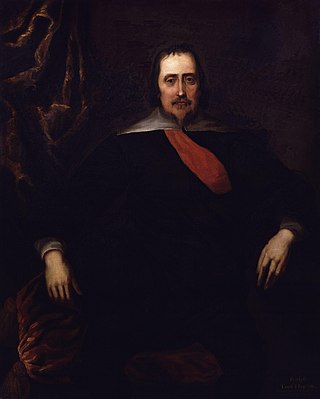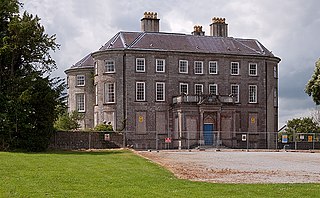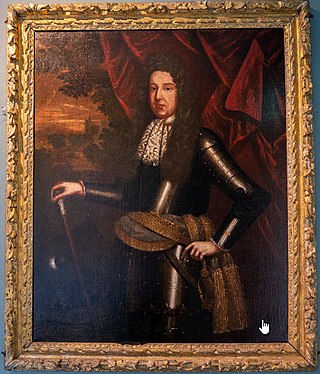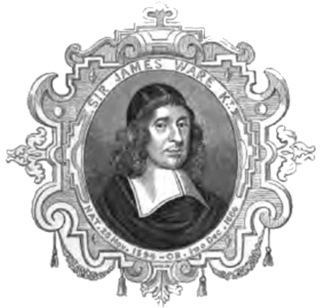Related Research Articles

Lieutenant-General James FitzThomas Butler, 1st Duke of Ormond, KG, PC, was an Anglo-Irish statesman and soldier, known as Earl of Ormond from 1634 to 1642 and Marquess of Ormond from 1642 to 1661. Following the failure of the senior line of the Butler family, he was the second representative of the Kilcash branch to inherit the earldom.

Ralph Hopton, 1st Baron Hopton was an English politician, military officer and peer. During the First English Civil War, he served as Royalist commander in the West Country, and was made Baron Hopton of Stratton in 1643.
Thomas or John Carte (1686–1754) was an English historian with Jacobite sympathies, who served as a Church of England clergyman.

Sir William St LegerPC (Ire) (1586–1642) was an Anglo-Irish landowner, administrator and soldier, who began his military career in the Eighty Years' War against Habsburg Spain. He settled in Ireland in 1624, where he was MP for County Cork in two Irish parliaments and Lord President of Munster. During the Irish Rebellion of 1641, he played a leading part in suppressing the rising in Munster before dying in 1642.

}} Sir Hardress Waller, c. 1604 to – 1666, was born in Kent and settled in Ireland during the 1630s. A first cousin of Parliamentarian general William Waller, he fought for Parliament in the Wars of the Three Kingdoms, becoming a leading member of the radical element within the New Model Army. In 1649, he signed the death warrant for the Execution of Charles I, and after the Stuart Restoration in 1660 was condemned to death as a regicide.

The Wars of the Three Kingdoms, sometimes known as the British Civil Wars, were a series of intertwined conflicts fought between 1639 and 1653 in the kingdoms of England, Scotland and Ireland, then separate entities united in a personal union under Charles I. They include the 1639 to 1640 Bishops' Wars, the First and Second English Civil Wars, the Irish Confederate Wars, the Cromwellian conquest of Ireland and the Anglo-Scottish war (1650–1652). They resulted in victory for the Parliamentarian army, the execution of Charles I, the abolition of monarchy, and founding of the Commonwealth of England, a unitary state which controlled the British Isles until the Stuart Restoration in 1660.

Sir Phelim Roe O'Neill of Kinard was an Irish politician and soldier who started the Irish rebellion in Ulster on 23 October 1641. He joined the Irish Catholic Confederation in 1642 and fought in the Wars of the Three Kingdoms under his cousin, Owen Roe O'Neill, in the Confederate Ulster Army. After the Cromwellian conquest of Ireland O’Neill went into hiding but was captured, tried and executed in 1653.

The Irish Rebellion of 1641 was an uprising by Catholics in Ireland, whose demands included an end to anti-Catholic discrimination, greater Irish self-governance, and return of confiscated Catholic lands. Its timing was partially driven by the dispute between Charles I and his opponents—the English Parliamentarians and Scottish Covenanters—which the rebels feared would lead to an invasion and further anti-Catholic measures. Beginning as an attempted coup d'état by Catholic gentry and military officers, it developed into a widespread rebellion and ethnic conflict with English and Scottish Protestant settlers. It led to the 1641–1652 Irish Confederate Wars, part of the Wars of the Three Kingdoms, with up to 20% of the Irish population becoming casualties.

Sir Donough MacCarty, 1st Earl of Clancarty (1594–1665), was an Irish soldier and politician. He succeeded his father as 2nd Viscount Muskerry in 1641. He rebelled against the government and joined the Irish Catholic Confederation, demanding religious freedom as a Catholic and defending the rights of the Gaelic nobility. Later, he supported the King against his Parliamentarian enemies during the Cromwellian conquest of Ireland.

Sir James Ware was an Anglo-Irish historian.
Alexander MacDonnell, 3rd Earl of AntrimPC (Ire) (1615–1699) was a Catholic peer and military commander in Ireland. He fought together with his brother Randal on the losing side in the Irish Confederate Wars (1641–1653); and then, having succeeded his brother as the 3rd Earl of Antrim in 1683, fought in the Williamite War (1688–1691), on the losing side again. Twice he forfeited his lands and twice he regained them.

Daniel O'Brien, 3rd Viscount Clare, was with King Charles II in exile during the interregnum. At the Restoration, he obtained the title of Viscount Clare for his grandfather and full restoration of the family's lands. At the Glorious Revolution he supported James II, sitting in the Patriot Parliament and fighting for him at the Battle of the Boyne. He was in consequence attainted as a Jacobite.

Connor O'Brien, 2nd Viscount Clare was the son of Daniel O'Brien, 1st Viscount Clare and Catherine FitzGerald, a daughter of Gerald, 14th Earl of Desmond.

Sir Theophilus Jones, was an Irish soldier and government official of Welsh descent. One of five sons born to Lewis Jones, Bishop of Killaloe in the Church of Ireland, he formed part of a close-knit and powerful Protestant family.
Ireland during the Interregnum (1649–1660) covers the period from the execution of Charles I until the restoration of the monarchy under Charles II in 1660.
Daniel Hutchinson was an Irish Protestant Dublin merchant who supported the Cromwellian Occupation of Ireland. During the Interregnum he served as Mayor of Dublin, a member of parliament of the Barebones and First Protectorate parliaments, Sheriff of County Dublin and Wicklow, and as Treasurer of Public Revenue in Ireland.
Perkins Crofton (1705-1768) was an Anglican priest in Ireland in the 18th century.
John Hamilton, was an Irish army officer of Scottish and Irish origin, who fought in the Williamite war in Ireland on the side of the deposed James II. He died from wounds received at the Battle of Aughrim.
Maurice Roche, 8th Viscount Fermoy (1597–1670) was an magnate and soldier in southern Ireland, and a politician of the Irish Catholic Confederation. He joined the rebels in the Irish Rebellion of 1641 in January 1642, early for Munster, by besieging Richard Boyle, 1st Earl of Cork, a Protestant, in Youghal. He fought for the Confederates in the Irish Confederate Wars and sat on three of their Supreme Councils. He fought against the Parliamentarians in the Cromwellian conquest of Ireland and was excluded from pardon at the surrender in 1652. At the restoration of the monarchy in 1660 he recovered his title but not his lands.
Redmond Roche was an Irish politician who sat for County Cork in the Parliament of 1640–1649. He was a Protestant during his earlier life but joined the Confederateses in 1642.
References
- ↑ "Toby Barnard retires" in The Hertford College Magazine, No. 92, 2012, pp. 29-31.
- ↑ BARNARD, Dr Toby. British Academy. Retrieved 11 June 2015.
- ↑ Alan Ford. Review of Barnard, Toby, A New Anatomy of Ireland: the Irish Protestants, 1649-1770. H-Albion, H-Net Reviews. January, 2005. Retrieved 11 June 2015.